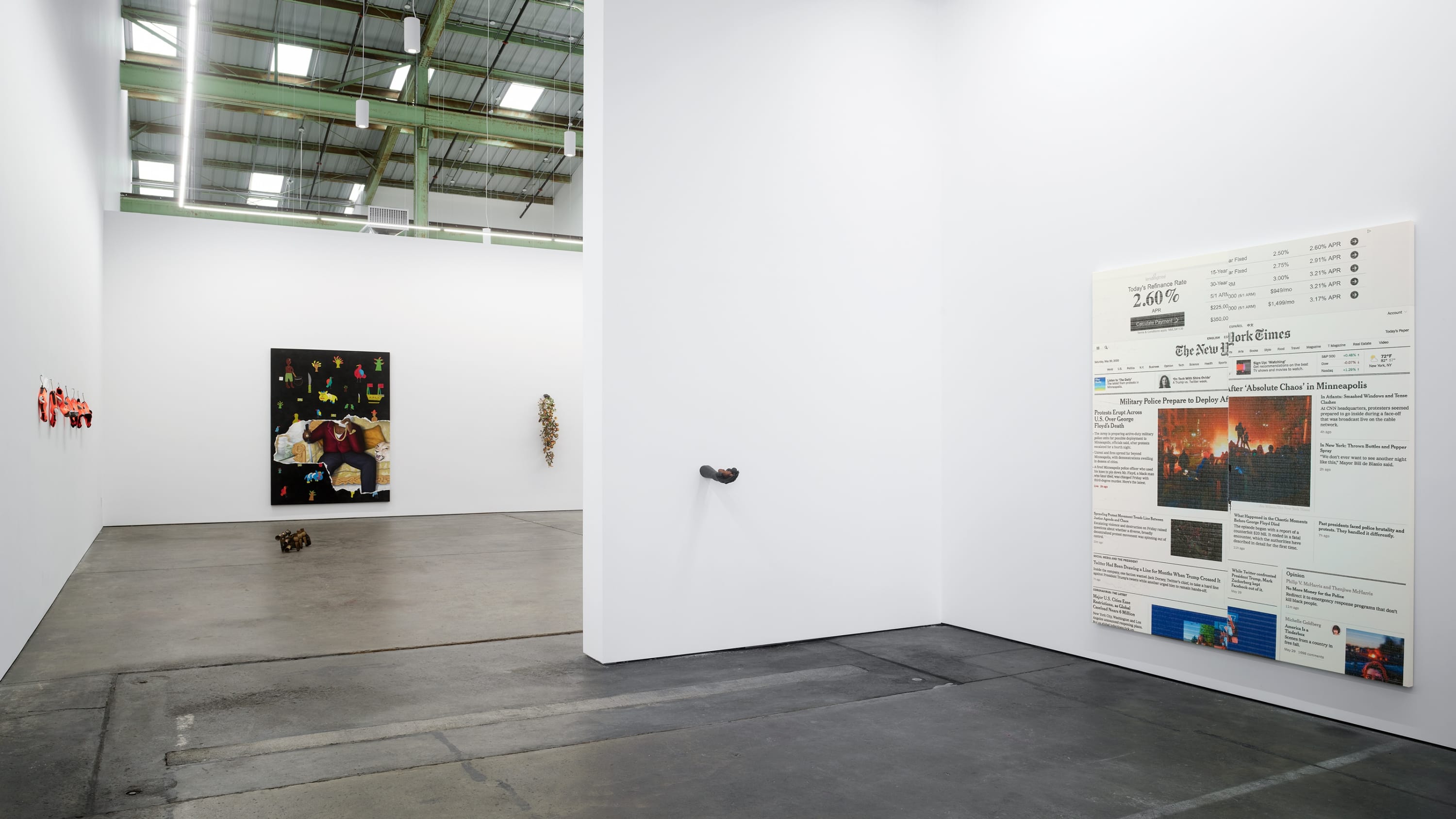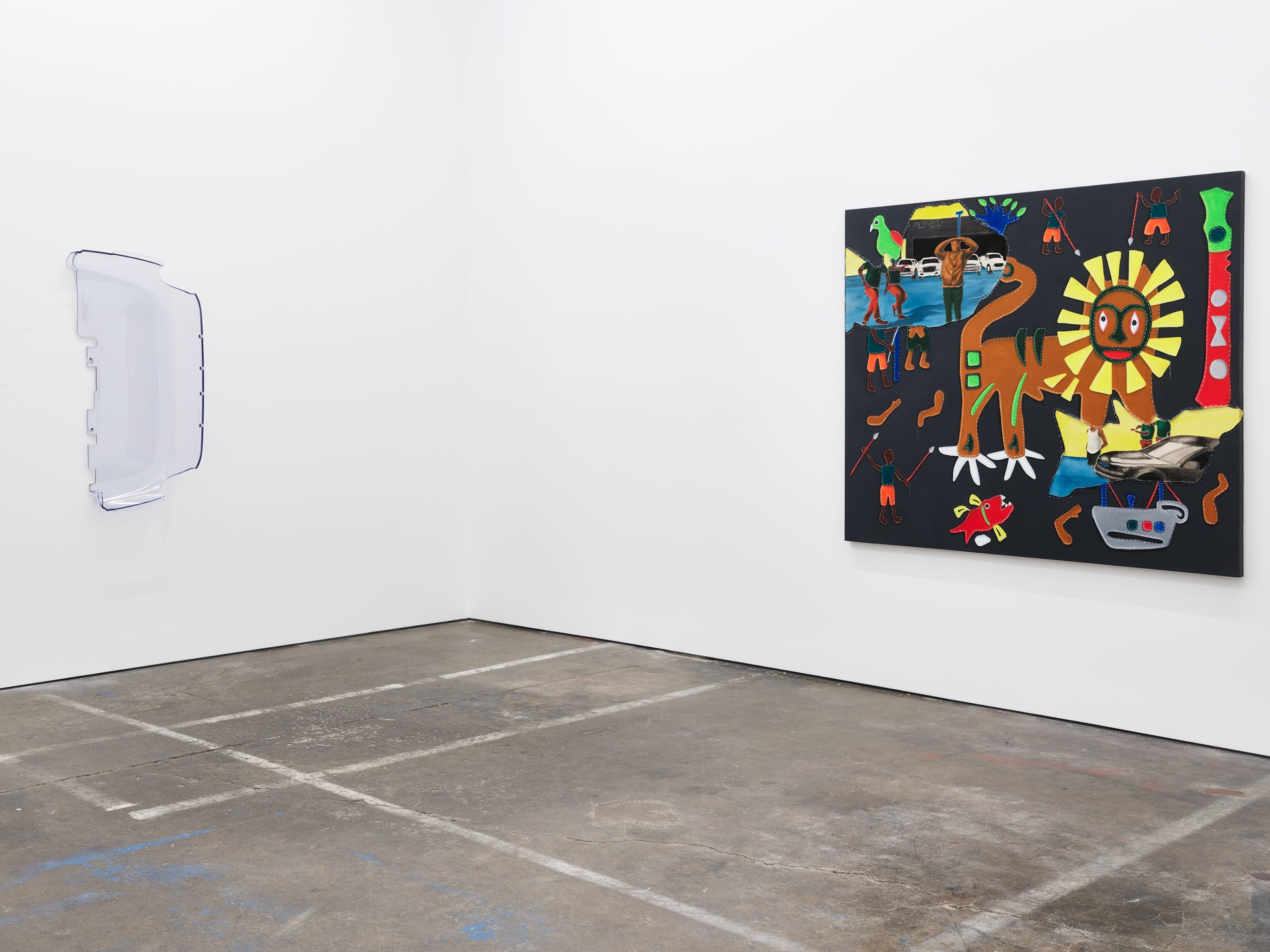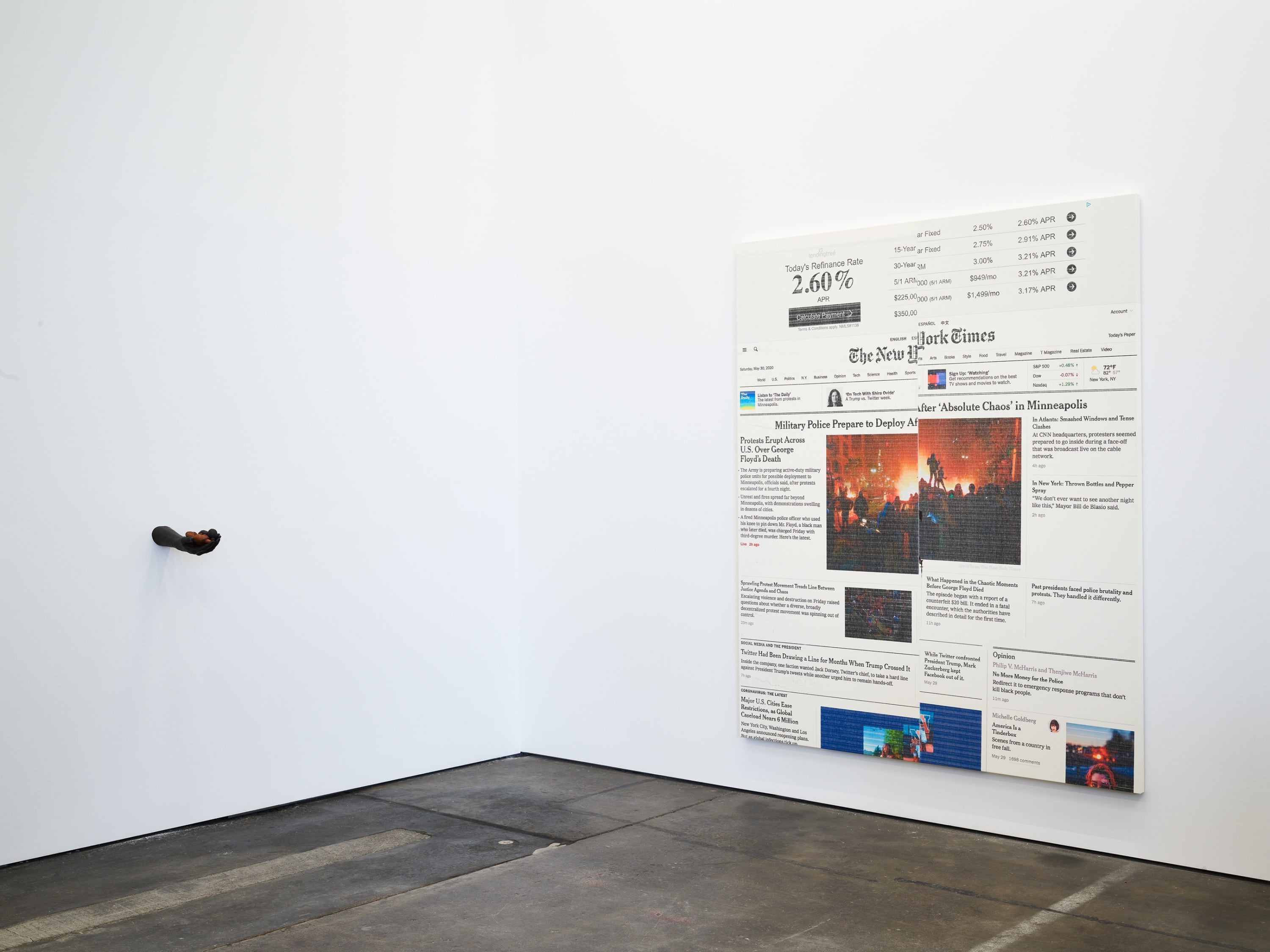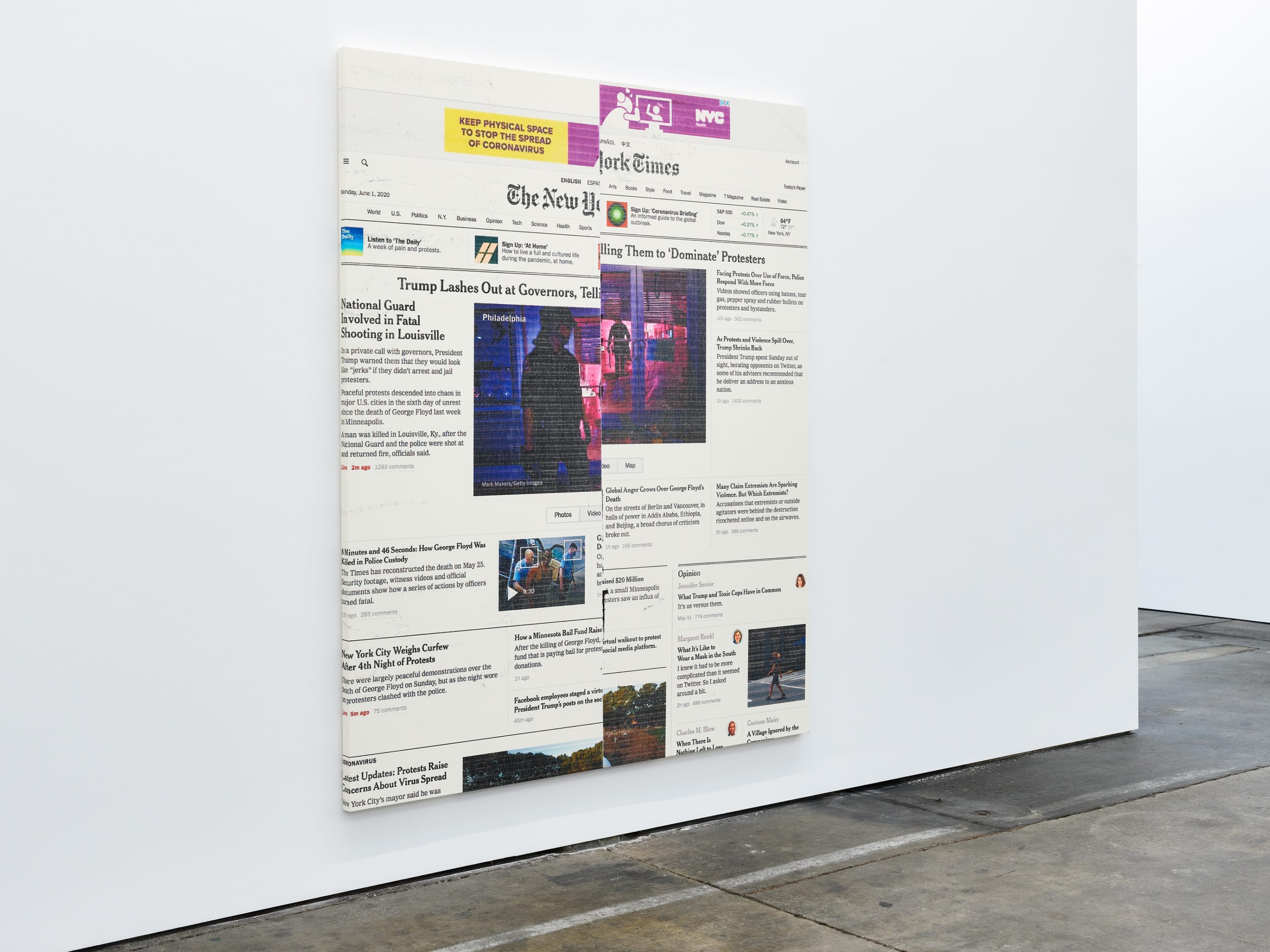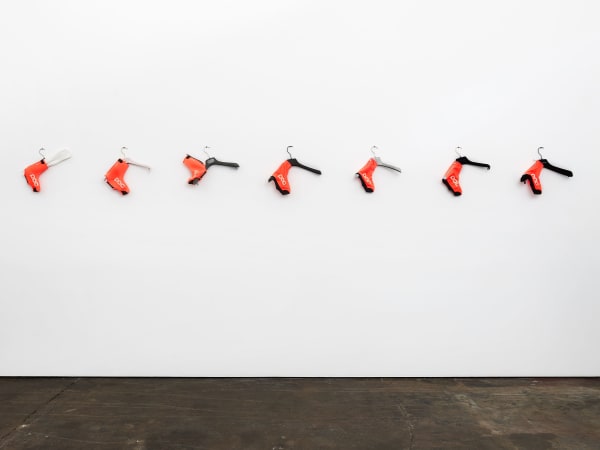I Yield My Time. Fuck You!: Nick Cave, Troy Chew, Wade Guyton, Samuel Levi Jones, Lynn Hershman Leeson, K.R.M. Mooney, Torey Thornton
-

-
The yielding of time signals a consciousness of how little space and agency we are granted – and the importance of leaving some for those who too often go unheard. Three weeks into nationwide protests against police brutality brought on by the murder of George Floyd, the Los Angeles Police Commission hosted a virtual community meeting via Zoom. After six hours of citizens decrying the police department’s violence and most recent misconduct towards demonstrators, Jeremy Frisch wasted none of his 30-second time limit. This exhibition takes its title from Frisch’s eloquent tirade turned viral rally cry.
-

-
It is not just Frisch’s perspective or his delivery that warrants consideration since we can imagine that there must be infinite unrecorded accounts of frustrated citizens in board rooms drilling civic authority figures, perhaps even with similar heights of style and punctuation. The reason any of us have heard of this specific moment is due to a sort of perfect contextual storm that surrounded and amplified Mr. Frisch’s exclamation through a unique social moment crossing paths with new technological possibilities for historicization and iconography. For every instance that gets captured and made iconic through mediation and memetic transfer there are infinite accounts that never enter the discourse and are denied their proper platform in society and in history. Every police video we see for instance, must stand in for a thousand other similar events not caught on tape. Technology has become essential to our aesthetic construction of histories and to our projections of the future, both for those in power and for the otherwise voiceless.
-

-
In moments of revolution we might locate clarity through distance from our prior consciousness. 2020 has offered arguably the most refined example of such an opportunity in our collective lives. Works exhibited six months ago might find radically different meaning within our new social context. With that in mind our exhibition proposes juxtapositions between different artist methodologies regarding societal collapse and social upheaval. Models of representation for these types of historical fulcrums can pull from a spectrum of sources, ranging from future fantasy aesthetics to something more closely resembling documentary. The reverberation between different methodologies is where the crux of the exhibition lies.
-

-
Uplifting and reifying otherwise distressed bodies, Nick Cave encourages a profound and compassionate analysis of violence and its effects as the path towards an ultimate metamorphosis. The figure remains central in Cave’s exhibited series of work, juxtaposing body parts in bronze monochrome, including casts of his own hands emerging from the gallery walls. One pair of hands cradles several miniature carved wooden heads, while another grips a delicate tole flower bouquet affirming the potential for new growth. The African heads import not only the ancient history of African carving and trade in stolen artifacts but also, more horrifically, the trade in stolen people, yet their individuality suggests something more nuanced about identity and collective psyche within an exploited race.
-
-

-

-
-
Troy Chew’s work looks methodically at systems of communication amongst the African diaspora. In his series, Out the Mud, Chew draws parallels between symbols and patterns in West African Mudcloth and painted portrayals of contemporary Black culture and resistance. In his most recent painting, the artist replicates brightly-colored hand sewn totems of Abomey appliqué symbolizing the different kings of the region that ruled from 1600-1900. Interspersed within the depictions in the newest work are vignettes recognizable as iconic and memetic scenes of contemporary Black oppression and uprising.
-
-
-

-
Samuel Levi Jones’s practice is an ongoing physical undoing of material and objects that hold an authoritative or iconic influence and power. He uses labor and aggressive process-based gestures to undermine and redistribute a material’s conventional or historical influence, giving way for new and reconsidered potentials. In Resolute, 2020, Jones continues his process of deconstructing academic reference books by stripping them of their covers and repurposing their material components into large-scale wall works reminiscent of painting and assemblage histories. Art, encyclopedia, history, and law books are sites of historicization that have largely ignored the contributions of marginalized groups, or codified their oppression. In disassembling these objects Jones alludes to the information that has been left out of print. For the first time, he has incorporated text into the work, interjecting his own voice into the previously abstract assemblages.
-
-

-
Included in the exhibition are two new paintings from Wade Guyton’s ongoing series using images captured from The New York Times website. The topical headlines chosen by Guyton in these specific works, illustrate the mediation of societal upheaval during a period of restricted access to free movement. The works occupy a disorienting space where digital and analog intersect, and the real and immaterial overlap. Information and aesthetics at once spectacular and mundane, forged through an extensive obstacle course of mediation are further compounded when the paintings are inevitably photographed and digitized for web consumption. The act of the screen capture that initiates Guyton’s process and the subsequent printing of the material, like a backup of important documents, is a coy game of resistance to impermanence within the aggressively and exponentially fleeting presence of 21st-century news, as well as a commentary on the value of the unique object within the history of art.
-
-

-
-

-

-
Lynn Hershman Leeson’s performative sculpture Present Tense confronts environmental abuse using a sophisticated tracking system of water contamination. Monitoring data sourced from bodies of water in the San Jose, Silicon Valley region, the work traces waste from the computer and semiconductor industry. A high-definition video of babies swimming innocently underwater is obscured by a water-filled tank illuminated by live data feeds that shift in color to illustrate water toxicity levels. The image is filtered with color effects calculated by a complex algorithm that actively responds to its environment, revealing truths about water toxicity in the region in which it is shown.
-
-
-

-
-
For K.R.M. Mooney’s work Strike i-iii, three cast objects in the shape of tenor bell strikers stand in line on the gallery floor, each leaning on the still-connected mechanisms involved in its casting—sand-casting “gates” and funnel-like sprues—that would typically be removed and disposed of in the casting process. The presence of the gates and sprues obscures the striker referent and aestheticizes the objects but perhaps even more crucially the intact supports index the material excess involved in industrial production, allowing the trace of process, labor, and surplus to hold equal status with the “finished object.” Unsealed, unsanded, unvarnished bronze preserves the unaltered surface results of production while also opening the work to inevitable change over time, complicating the notion of an object reaching a complete state of form or being. In its designed function a striker would produce sound through contact and reverberation. These disembodied strikers conjure ghost sounds of bells echoing. Like the artist’s other recent works, Strike i-iii finds the latent talents of objects or materials, such as the ability to make sound, or to have a voice at all, transposed and expanded into contingent material properties, physical interactions with space, and processes of production.
-
-

-
Fashion is commonly used as an aesthetic indicator of the times. Like the construction of history, fashion is an active document of a collection of drives and perspectives continuously subject to reevaluation through new lenses of perspective. Torey Thornton’s elegant yet self-aware arrangement addresses clothing as sculpture for the body. Activated by the movement of our bodies, clothing is essential in performing our identities. The impenetrable and fraught high-taste high-class economic stakes of the fashion industry mirror our present art market conditions. Both go back and forth between cause and effect designations as they pertain to economic, ecological, and social trauma. Within both constructs a constant reevaluation is at play, never truly at rest in a “present,” and new meaning is commonly accrued over time or via changing circumstances. In Thornton’s Who's teaching to hang dry? (All rights and 1 left, intro to seven deadly sins), seven luxury brand designer hangers hang in a row on a wall—Alexander McQueen, Rick Owens, etc. Grabbing onto each hanger is a bright neon orange thermal overshoe bicycling booty from a Swedish company called POC, with the POC graphic featured prominently on each booty. As technological and social constructions advance, who within those industries and ideologies will thrive through new framings and who will suffer, be revealed, or go extinct? Which pressures, restrictions, drives, and presumptions will determine the viability of those who dictate the aestheticization of the collective present?
-
-

-
-

-
-
-
For more information and artists’ bios please contact info@altmansiegel.com or 415-576-9300.

